An Attempt at a Full-Scale Taxonomy of Visio-Textual ArtBob Grumman
Although modern visio-textual art has been around for most of the century, it has for a long time been without a satisfactory taxonomy, although a few scattered eccentrics, I among them, have named bits and pieces of the field. Now, however, it has found its Linnaeus--in the person of Me. Or so I will attempt to establish here.
My visio-textual taxonomizing began some twenty or so years ago, in the early seventies. Exposed then to the Emmett Williams and Mary Ellen Solt anthologies of concrete poetry, I realized that certain poems therein were not verbal! That is, while they had
textual matter, they had no words! How could poetry, from ancient times a verbal art, have no words? The taxonomic solution to this seems simple now, but it took me a while to figure out. I simply separated art comprised of both textual and visual matter into two kinds, one in which the textual matter has precedence, and one in which the visual matter has precedence. I called the first of these "visual poetry," a term others were using at the time for "concrete poetry" and which I thought more precise than the latter (as well as free of certain unfortunate socio-polical connotations that "concrete poetry" had begun
accumulating). I tried various names for the other of the two, settling (after many years) on "textual illumagery," the latter word being my term for visual art.
The two kinds of art together I came to call "vizlature" (for "visual literature," even though I question whether textual illumagery is a kind of literature). Later I expanded
"vizlature" to its present meaning as art that contains both textual and visual matter (or: visio-textual art).
The first poet outside the Solt and Williams anthologies whose work I tried my taxonomy out on was Karl Kempton. His vizlature split quite neatly into my two kinds. Take, for instance, his "JUMP/SKIP/FLIP/LEAP," the poem directly following. On the surface, it depicts in op-art fashion exactly what the words in its title verbally mean--with consonance and a rhyme visually as well as auditorily collaborating in the process, and glittering into the pleasant surprise of the poem's identical four smallest rectangular prisms. At the same time, on a subtler level, the poem forms a pulsatingly energized flower to visually serve as what I term a "juxtaphor" (or implicit metaphor) for the child-
lithe love of the physical life that jumping, skipping, flipping and leaping express. In short, the poem's words say what it is about, and its visual representation on the page expands what it is about into poetry. It is thus clearly a visual poem.
|
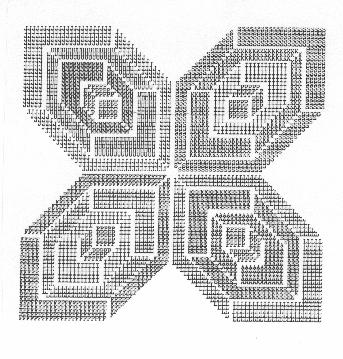
|
It is also an example of a classical concrete poem in that it contains nothing but text. There are still those who argue that a genuine visual (or concrete) poem should, like Kempton's poem, rely on the arrangement of its text only for its visual effect. The poem by Clemente Padin below, with its boarded window acting as a juxtaphor for what the death of her husband does to a woman (i.e., both reduces her by a letter, and closes her) would thus not qualify as a visual poem. This is absurdly limiting--and a leading reason that "visual poetry" is in much wider use now than "concrete poetry" for speaking about these sorts of poems.
|
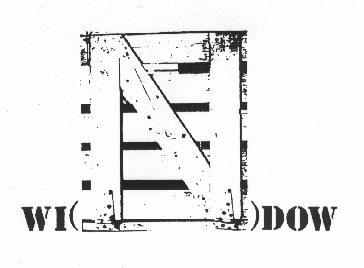
|
Another Kempton work, a piece from a sequence in homage to Erik Satie that he composed on an electric typewriter in 1976, nicely demonstrates what I mean by a textual illumagery, for although it is entirely textual, consisting of nothing but upper-case D's, it has no (explicit) words. One at first wonders what the point of the D's is--why D's instead of A's or Q's or dots or dashes of purple? A study of the occult sciences and related disciplines might provide the answer, for I know Kempton to be highly conscious of the numerological, astrological and/or hermetic values of the letters he chooses. For those of us without a Jungian temperment, though, the letters' suggestion of sounds and near-sounds, and of language, and their visual value as design elements are their only aesthetic value. That, however, turns out to be a great deal. As dots of sound or near-sound, the
D's here seem to chant the poem they comprise into unsilent being. Meanwhile, by severely reducing his D's connection to language, Kempton alerts us to their visio-aesthetic charms--such as the tension between their rounded and straight sides (which brings sail-filling breezes to mind, among other things, for me).
|
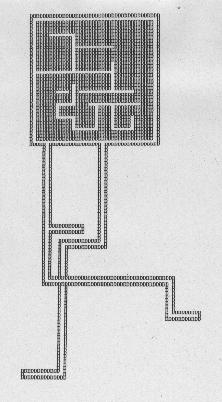
|
But the D's retain their identity as elements of language however asemantically Kempton has used them, so also suggest something of the way dots of language build matter. At the same time they build a second tension, this one between their ambience as abstract symbols and the Klee-like purely sensual appeal of the visual design Kempton has created. This latter, by the way, I see as depicting a fellow half-jumping as he holds up a poster bearing Good News (and how the D's vivid change from outline to background accentuates that Good News!), but it is obviously open to scores of other equally plausible, and enjoyable, interpretations. By any standard, the work is a wonderful piece
of art, whatever it's taxonomized as, and I emphasize this to fight the misconception of so many in the field that to call something not a visual poem is to denigrate it. For me the
best textual illumages have always been absolutely as good as the best visual poems.
For a while my simple division of vizlature into visual poetry and textual illumagery worked quite well. Then I began being exposed to visio-textual collages, like the work below, which is from Bill DiMichele's 1983-4 sequence, (Above) At The Meeting Of White Witches. Here (and interactively throughout DiMichele's sequence as a whole) the juxtapositioning of incongruous texts and graphics boils up a brew rich enough to keep commentators going for decades. Among the highlights: the wend of "in" from "brains" to "things" to "unkingly" to "thin"; the strange brother-or-cousin act of "briars" and "brains"--with each other and with "Tee thand things" (which calls to mind images of the brain as briars/teeth that catch things/cause pain); the relationship of Jesus, especially the Jesus of the Turin Shroud, to credit cards; the significance of the other references to religion, and to the chart of the "cosmic octaves of radiation" a part of which DiMichele shows here; the distorted man fondling the somehow sexually vibrant female carcass so near "briarsand
brains"; the "thin fairgrounds" that consciousness, or reality, ultimately is . . . Such a combination of words and graphics had to be considered a visual poem--but it was so much different from visual poems like Kempton's "JUMP/SKIP/FLIP/LEAP!" Moreover,
if I defined it as visual poetry, wouldn't consistency compel me to include comic books, cartoons, illustrated poems--any combination of texts and graphics, in fact--in my visual poetry category? I thought it would. So I added a third category to vizlature. I named it "illuscriptation" at first, then "illuscription." The difference between an illuscription and a
visual poem seemed easy enough to pin down: the first's visual elements were separate from its textual elements whereas the second's were fused with its textual elements.
|

|
My taxonomizing gained momentum from that point on. Soon I was distinguishing visual poetry from "visually-enhanced poetry," which is poetry printed in a manner that increases its ability to please but does not significantly amplify its core meaning; a poem written in a beautiful calligraphy would be an example, or a poem whose initial letter is in color and perhaps made into a picture as in certain illuminated manuscripts. So I decreed that the visual part of a visual poem had to work metaphorically with its verbal part. When this proved unwieldy, I backed down (though I continue to believe that most of the best visual
poetry is visio-textually metaphoric). My definition of visual poetry became: poetry containing visual elements that are fused with, and approximately as expressively consequential as, its verbal elements.
For several years I was content with my four categories of vizlature: visually-enhanced poetry, visual poetry, illuscription and textual illumagery. Recently, though, "illuscription" became problematic. First of all, it covered too much that was clearly not poetry (like cartoons); it also covered visio-textual collages that almost everyone in the field called visual poetry; and it covered poems (illustrated poems) that no one considered
visual poetry. Consequently, I decided to use it as my term for comic books, comic strips and cartoons only, and re-assign the poetries I had been calling illuscription to some other category of vizlature. I decided there were just two poetries to re-assign: (1) illustrated poetry, whose name should be self-explanatory, and (2) poetry containing but not fused with aesthetically consequential visual elements--which I named "visiocollagic poetry" because it is so often a kind of collage. The former I put in my visually-enhanced poetry category, the latter in my visual poetry category.
Since I had previously considered only vizlature whose visual and textual elements were fused to be visual poetry, I now needed a name to distinguish such poetry from its new partner in the visual poetry category. I dubbed it "visualloyic poetry," the adjective being a combination of "visual" and "alloy." "Visualloyic" and "visiocollagic" are stumbly long names but it shouldn't matter much as it's unlikely they'll be used by anyone but connoisseurs and similar specialists. For such persons, however, they should be useful. Of course, if anyone were to come up with better names for these--or any of the other awkwardly-named poetries in my taxonomy--I'd be delighted.
One other task I had to take care of was naming illustrated poetry's now nameless partner in the visually-enhanced poetry category--the kind costumed in purely-decorative calligraphy or the like. I was straight-forward this time, naming it "typographically-heightened poetry."
So involved did I get with my definitions and neologies that I finally recognized that the textual and visual elements of many pieces that even I at my most rigorous termed visual poems were not truly fused as I claimed they should be in such poems. The Padin piece below illustrates the problem. The hand depicted in it is not fused with its words although it is unarguably an intimate part of the sentences the poem half-spells (such as the amusing one about the unfortunate miscompletion of the delicate "idea" with a letter from the leaden "word"; or, going in an opposite direction, the one about how precisely the creative
hand must place each letter to build something viable out of language). Ergo, I refined my definition of visual poetry to: poetry containing visual elements that are fused or otherwise clearly integrated with, and approximately as expressively consequential as, its verbal elements.
|
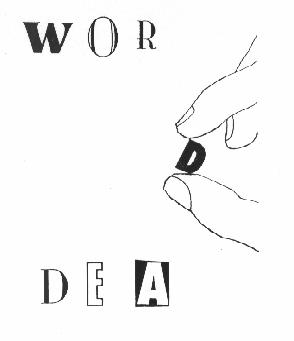
|
As for textual illumagery, I now divide it into textualloyic illumagery and textcollagic illumagery, to parallel visualloyic and visiocollagic poetry. Textualloyic illumagery is art
consisting of averbal textual matter that is fused or otherwise clearly integrated with its visual matter. (It can also contain verbal textual matter that is obviously of no semantic
significance like a cut-out from a newspaper shaped to represent a man, the particular words in the news-stories having no real relevance--they're just there to indicate that the man is composed of language, or of news, or whatever.) Textcollagic illumagery, like visiocollagic poetry, is visio-textual art whose visual and textual elements are separate from one another. It differs from visiocollagic poetry only inasmuch as its textual
elements are averbal.
I continue not to warm to the idea of counting textual illumagery as visual poetry, but it seems few in the field are going along with me. And there is some sense in the argument that the textual elements of such art put an aesthcipient significantly in the verbal part of his mind as well as the visual: by providing a verbal ambience, and by being pronounceable (or nearly so), and in discussing language if not quite becoming it. So my
position now is neutral: I offer textual illumagery as a form of vizlature and leave it up to the rest of the world (albeit mainly those working in vizlature as poets and/or critics, I hope) to decide whether it ought to be considered visual poetry.
To round off my system, I include under vizlature a category which is for text-containing visual art that is not textual enough to be textual illumagery what my visually-enhanced
poetry category is to graphics-involved poetry that is not graphic enough to be visiocollagic or visualloyic poetry: infoscriptioned illumagery. The adjective in that term
comes from "infoscription," my term for such things as captions, titles, labels and comic-strip dialogue-balloons (which can be considered elaborate labels for drawn characters' speech). To put it simply, infoscriptioned illumagery is visual art that has labels or the like affixed that are basically informational rather than expressive. So a painting of a streetscene with the names of stores displayed, making it textual, would not be a specimen of textual illumagery.
Going the other way--to a taxonomical level above visual poetry, that is--I've set up the category, "pluraesthetic poetry," for poetry that breaks expressive decorum by making more or less as much, and as important, use of one or more other expressive modalities than the verbal such as mathematics, music or visual art. It would exclude infoscriptioned illumagery as not poetry but cover everything else mentioned (unless it were agreed that textual illumagery were not poetry, either). Higher up in my system there's "Burstnorm Poetry," followed by Poetry, then Literature--which completes my taxonomy as far as vizlature is concerned.
Needless to say, my taxonomy is not perfect. Not only are some of the names of its categories less than sonorous or memorable, but the sheer number of sub-divisions in it multiplies what bp Nichol called "border blur" to make subjective guesswork hard to
avoid. What, for example, is a Grummaniacal Taxonomist to make of the following piece by W. Mark Sutherland?
|
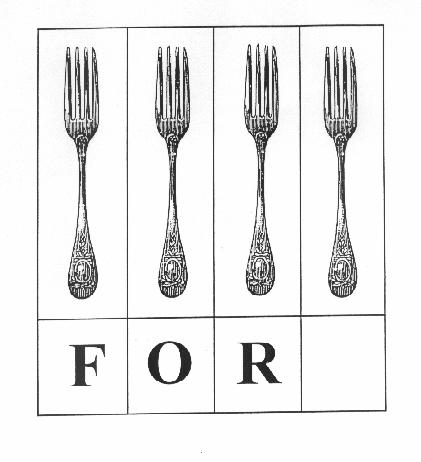
|
This gave me all kinds of trouble. In a way, it's just a picture of forks, with a peculiar label (plus a title), which would make it infoscriptioned illumagery. But the (to me, brilliant/hilarious) point of the piece is the abruptly "mathocentric" refusal of the label to finish, preferring to mispell what is of mathematical significance in the picture than to say what it depicts, and that depends on something visual, the absence of a letter. That absence could be just verbal--except that it wouldn't be noticed if it didn't happen in a designated frame, under a picture that seems to expect a fourth letter to finish naming it. The text and graphics of the piece assuredly work together to produce its main aesthetic/philosophical meaning--and do so integratedly. Therefore, in spite of first
appearing to be too secondarily textual to even be textual illumagery, then--fleetingly--seeming perhaps visiocollagic, it finally proves to be a visualloyic poem . . . in my expert but subjective opinion.
|
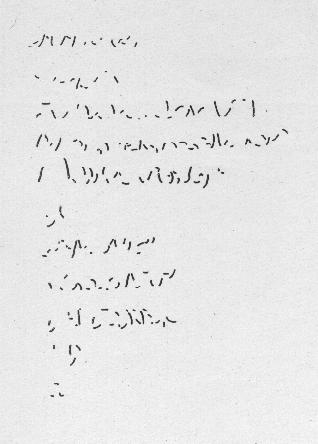
|
Far easier to classify is jwcurry's "LINE 4." It is almost surely a deteriorated poem of some kind but now illegible. It is therefore a textual illumage--to be precise, a textualloyic illumage--whose subject is the disintegration of texts, or poems, or language, or whatever (bringing to mind Ozymandias, among other things). Or maybe it is about language slowly coming to life.
|

|
Similarly, the arresting "review" of (or response to) b. dedora's he moved, which is also by curry, is a textualloyic illumage--which suggests interesting things about fading-or-
congealing bits of language, in contrast with an established "word" (the "bihhh")
|
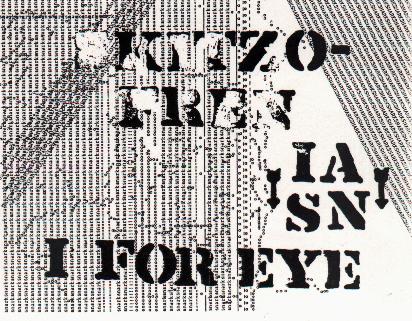
|
But then there's Mark Laba's snark piece, which seemed similarly textual but not verbal to me. In another essay I said the following about it, "If some critic can paraphrase its verbal
fore-burden and show how that connects with its visual matter, I'll (ahem) allow it to be called a visual poem, but for now it looks to be a textual illumage to me." Luigi-Bob Drake took
up the challenge. Here's what he said in an e.mail letter to me:
"th top level, in stenciled letters, reads: "skitzofrenia is an i for eye". schizophrenia is "misspelled", with the substitutued "skit" homophone emphasizing the dramatic (as well as praps role-playing?) aspect of th clinical imbalance referred to. "skitzo-frenia" is also partially obscured, whited out, as many schizophrenics attempt to hide or deny their condition--and as society, too, is apt in some circumstances to be in denial ov mental illness. next, visual cues, in the form ov the arrows, are given to force the vertical reading of "is" "an"--an "unnatural" direction, as well as a disjunction of the "ia" from it's preceeding word; in both aspects, the mode of perception is not the normal one, with iconic visuals taking precedence over traditional reading (thinking) habits. this leads to the last line, in which visual perception ("eye") is somehow in transaction with the self ("I") of the poem--traded for? substituted? or in place of? it suggests, to me, that th "I", th
schizoprhic subject ov the poem, has lost his "self", or her vision of "self", perhaps overwhelmed by perceptions too chaotic or distorted to be intepreted...
"but what ov the Snark, in the background level of the poem? obviously referring to the Lewis Carroll poem, in which the crew goes off in search of the elusive creature, only to find that the particular Snark they are hunting is in fact a "Boojum"--and coming upon a Boojum, ov course, leads to one's own disappearance, as the hapless Baker finds out at the end of the poem. the hunt for the snark, and the resulting disappearance of the self, echoes th subject's search for sense in a visual realm & loss of sense of self w/in the disease. when the Baker disappears, he's in the process of saying "it's a boojum" but only gets out the first syllable of the last word--his final "oooo..." echoed in the background here, as well as echoing praps a cry of pain & loneliness that is so symptomatic of schizophrenia..."
So: the work is a visual poem, after all--a visualloyic one. And now that I've finally brought this essay into a patch of words by someone who knows what he's talking about, I think it's a good time to end it.
|